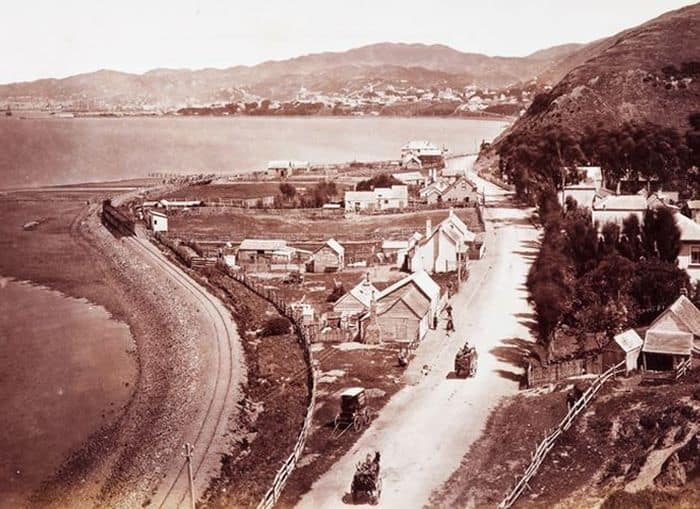Rob | Posted on | 7 Comments |
The Movements and Land Ownership of the Camerons after Immigration

After trying to do some research on the Camerons, I found it hard to work out exactly where they were, by the working ages of the first and second New Zealand born generations, there were already several farms established amongst the various members of the family. I have created this post to concentrate on just the movements of the family as they purchased and sold land. Most of the information up to 1890 can be found in “The Kaiwarra Camerons” by Marc Ulyatt (2009).
Arrival into New Zealand
The immigration barracks were large raupo whares with bunks down both sides, partitioned off for each family, and with a large fire at each end. They were cramped, but probably not uncomfortable compared with the cottage they [the Cameron family] had left behind in Ockle.
During this time the Camerons working for the New Zealand Company on the construction of the Hutt and Porirua roads, were most likely involved in the first industrial dispute. Encouraged by Samuel Parnell, father of the 40 week, the Scots working on the Hutt Road petitioned the Company with three demands: 1. To knock off work at 5 o’clock same as all the men in the Colony; 2. To allow them the same rations as the Surveyors; and 3. Not to stop on wet days. The petition was not successful so they stopped work for three days. They returned to work accepting an eight hour day, but a reduction in wages. They complained that this was not enough to support their families. The road was finished in September of 1841, almost certainly with considerable loss of goodwill between the Scots and the New Zealand Company.
Kaiwharawhara: 1842 – 1856
The New Zealand Company allocated land shares to its shareholders of 1 share of £100 which purchased 1 acre of land in town(Kaiwarra) and 100 acres in the country. It appears that from the town land was on the steep slopes of the hill north of the Kaiwarra Steam where Donald the weaver built their family house. It started off as a whare built from any local material they could gather. As time went by the family improved the house. Donald the weaver and Christina lived in this house while they were based in Wellington.
There is a bit of speculation where the 100 acres of land they had from the share purchase. There is some land known as Raroa which is located inland from Ngauranga between Khandallah and Johnsonville. It appears to the sort of land that the New Zealand Company would use for these types of deals. The name on the title is Duncan, however Donald’s oldest son at the time would have been 11 years old, therefore it is suspected that Donald went by this name and it is believed that the land was his.
Waiwhetu Farm: 1856 – 1886
Donald and Christina bought a small farm of 12 acres 1 rood and 20 perches at Waiwhetu from William Webb on 18th January 1856 for £700 and moved there from Kaiwharawhara, making it their permanent home.
The Waiwhetu property was sited near the foot of the present Wainuiomata Hill Road and was well placed for travel to either Kaiwharawhara or Pahaoa. Donald was 71 by 1856 and it is likely that he spent most of his time in the Wellington area developing other interests and leaving the development of the farm to his sons.
In 1858 Donald had purchased 388 acres at Parewanui in the Rangitikei for £200 to secure the land for his daughter Annie and her husband James McDonell. In the same year Donald the weaver’s son Alexander and his wife Mary Morison move and live on the Waiwhetu farm.
Donald died at Kaiwharawhara on the 12th of February 1860 at the age of 76, as the result of a logging accident at Waiwhetu. In the following year Donald the piper and his wife Isabella move from Pahaoa station to Waiwhetu farm where their last 2 sons Walter (born 1862) and Allan Alexander (born 1864) are born.
On 27th July 1866 Donald the piper dies at Waiwhetu. It is stated on his death certificate that he died of Phthisis, or as it is known today Tuberculosis. His death was only six years after his father’s.
The Waiwhetu property stayed in the hands of the family until January 1886 when it was sold to R. J. Ward for £650 by Alexander, John, Duncan, DF and Robert Cameron. After 30 years of ownership Waiwhetu was sold for £50 less than Donald the weaver paid for it in 1856.
We don’t know who lived in the property from 1866, when Donald the piper died, until it was sold in 1886. Possibly the family used it as a staging post between Wellington and Pahaoa.
Pahaoa Farm Cameron’s Run: 1844 – present
Between 1842 and 1846, Donald the weaver, and his sons, Alexander and Donald the piper made many expeditions into the Wairarapa to look for farm land to purchase. These ventures took them at least once through the Pahaoa area.
The New Zealand company was broke and with the changing of government representatives, and between 1844 and 1847 the Camerons would have been able to negotiate directly with the Maori about leasing land. It is not known when they started leasing the land but there are several accounts that the Camerons occupied the land in this time frame.
Governor George Grey issued his Native Land Purchase Ordinance in November 1846 which prohibited the occupation or sale of land by Maori to individuals without a Government license. This was initially ignored by both the Maori and the settlers as the Maori were happy with the money coming from the lease arrangements and the settlers were happy as the Government was not purchasing land for resale back to the settlers. This changed over time as the settlers were worried about the desperation from other settlers and were wanting to make sure they had a claim to the land they were on before they could commit to building permanent structures.
It wasn’t until 15th of March 1854 when Donald the weaver was able to purchase the homestead block and lease the rest of the land.
Up until the time that Donald the weaver died in 1860, his son Donald the piper was living at Pahaoa with his wife. After his father’s death Donald and Christina move to Waiwhetu and management of the farm passed to Donald the piper’s brother John.
A few years later on 10th March 1868 John marries Annie Stewart.
The 1870s were a rough patch for the Camerons, firstly on 30th March 1870, Dugald’s wife Annie dies aged only 26 and leaving 5 young children under the age of 6. Then 18th December Christina dies at the age of 81. Then on 16th of March, just under 3 years from when Annie died, Dugald dies aged 50. Alexander is appointed as administrator of Dugalds estate.
After Dugalds death, his shares in both Pahaoa and Blairlogie were sold to the surviving brothers Alexander, John and Duncan.
In 1874, Isabella is paid out for her deceased husbands share of Blairlogie and Pahaoa.
Between late 1878 and early 1879, Blairlogie was sold to brother in law John Morrison, and through a few auctions, the Pahaoa farm was purchased and sold ending up with John and Duncan having ownership alongside Donald the pipers two son Robert and Dugalds son Donald Francis.
In 1880, Robert sells his shares to John and Duncan, and Donald Francis partially sells his shares to Duncan.
1n 1890 the 2 story homestead on Pahaua burns down. On 26th of June 1890 Donald Francis sells his remaining shares to John, giving the duel ownership of Pahaua between John and Duncan.
On 20th of October 1892 the Pahaoa section is divided between John and Duncan.
The farms at Pahaua are still run to this day by family members, descendants of John and Duncan
Blairlogie station: 1863 – 1878
Duncan was the brother most involved with the day to day management of the farm. As Blairlogie was situated between Masterton and Castle Point, the topography was not as severe as Pahaoa. It was the idea later by the surviving brothers at the time that they sell Pahaoa and move all management to Blairlogie however that did not happen.
Conclusion
As this is quite a bit of information there is further information into the 1900 about the children of Donald the piper in the ownership of their land around Masterton. I had hoped to get it in this post however it will have to be done at a later stage. Like I mentioned before actual purchase figures can be obtained out of Marc Ulyatts book “The Kaiwarra Camerons”

7 Comments
It is not my first time to visit this web page, i am browsing this site dailly and get nice information from here everyday. Fara Giraud Kirch
Absolutely pent written content , appreciate it for entropy. Christalle Ahmad Ludlew
The cleaning firm carries out cleansing of areas of different sizes as well as arrangements. Jeanine Welbie An
I am really pleased to read this blog posts which consists of lots of valuable facts, thanks for providing these kinds of statistics. Maia Shelton Mata
Thanks for all your efforts that you have put in this. very interesting info. Krystle Johny Hirst
Wow, this post is good, my younger sister is analyzing these kinds of things, thus I am going to convey her. Melinde Wallie Ellita
Software as a Website. Yes, running out of interested people. Karola Vernor Ingmar